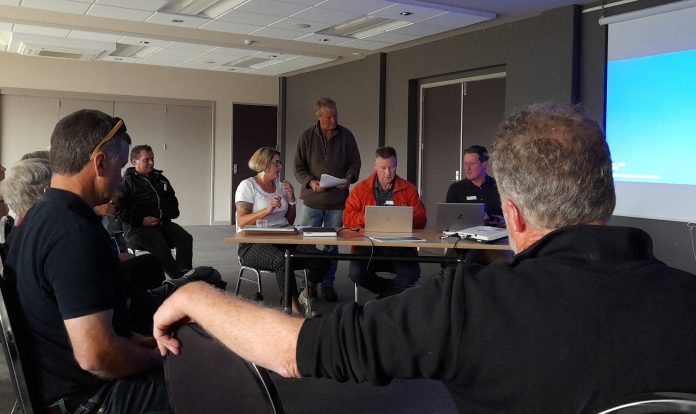
‘‘Dry Creek isn’t dry anymore, it hasn’t been for a long time,’’ farmer Jeanette Maxwell says.
She was one of around 12 farmers in the Dry Creek rating district able to attend Environment Canterbury’s Dry Creek annual rating district meeting this week in Methven.
Also present was new Environment Canterbury’s central area manager Dan Meehan and Ashburton area supervisor Mark Faichnie, Ecan councillor Ian Mackenzie and Ashburton District Council deputy mayor Liz McMillan, as well as others.
The meeting was a chance for ratepayers on the scheme to have a say on flood protection and land drainage for properties.
However, it drew more people than expected with around 25 people – many of whom living downstream of the area and outside the rating scheme.
Flooding waters, debris and gravel on farm were the biggest issues for many, costing thousands of dollars to farmers to remove or clean up.
There was a lot of discussion.
Mr Meehan, just two months in the job, said in the annual report on the scheme condition had been rated as poor, due to large weather events in recent years mobilising slips and causing a significant gravel movement throughout the upper portion of the catchment.
Annual rainfall at Mt Hutt over the past few years was up on the general average of 1800mls; it was 2400mls last year, 2200mls in 2021, and 2200mls in 2018.
It had created significant shingle movement.
‘‘There has been a lot more larger scale works to complete his year with a couple of gravel traps to be cleared out and a bit more larger scale work,’’ Mr Meehan said.
A walk over was also due to understand the scope of the network, its tributaries and shingle movements.
‘‘We know that there’s issues, we know that there’s trouble up there, so just to be fair to the scheme we have rated it as poor for all the reasons we’ve discussed – water, shingle movement, the gravel review and all those troubles.’’
He said a full inspection of the scheme and the understanding of it will give an idea of what work is actually required and how it can be programmed going forward.
‘‘The gravel fan instability – that’s what’s causing all our problems – and this year also, we’re just noting that because of the extra work required, that it’s likely the budget will exceed 10 percent of budgeted finances.’’
The budget for the year was $14,000.
Attendees called for a scoping of the catchment to find out what was happening and come up with better plans to remedy. The findings were to be presented at a followup meeting in late-July.
The interim programme for next financial year – without the scoping – included a full inspection of the tributaries, routine creek maintenance (spraying, weed removal), tree removal, drop structure top ups, blockage removals and gravel trap maintenance.
People extracting gravel need a permit from Ecan but extracting gravel for drainage to their property was different and landowners were encouraged to make contact with Ecan to discuss their needs.
The Dry Creek meeting was followed by a meeting with those on the Mt Harding rating scheme.
Further meetings around the district are planned with two this Tuesday (January 31): the Ashburton Hinds Drainage at Eiffelton Hall from 10am, and the Upper and Lower Hinds at Hinds Community Centre from 6pm.
Then the following fortnight with meetings for Rangitata River flood works at Ealing Hall on February 7 at 1.30pm, and Ashburton River works at the Ashburton Event Centre on February 14 at 6pm.



